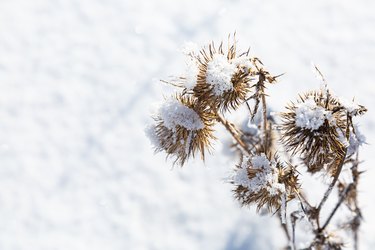
Sticker burrs (Soliva spp.) can turn an otherwise lovely yard into a minefield for bare feet. These small seed pods have spines that adhere to just about anything they touch, so getting them out of clothing or a pet's fur is an exercise in frustration — to say nothing of what they feel like on your skin. They tend to flourish in areas with dry and/or sandy soil, but these pesky weeds can grow in many conditions. Killing the weeds that produce sticker burrs is the key to keeping these burrs out of your lawn.
Timing Sticker Burr Treatment
Video of the Day
Timing is everything for killing burrweed. By the time you notice sticker burrs in your yard, it's too far into the year to get rid of them. These weeds germinate in the fall and start to grow rapidly in the late winter or spring, with small spiny seed pods developing at the tips of their leaves. As the plant matures over the spring and early summer, the seed pods harden and drop to the ground, becoming a painful nuisance.
Video of the Day
Even if you kill the weeds that produce sticker burrs in spring, you'll still be left with the sticky seed pods. The only effective way to keep these burrs out of your lawn is to eliminate the weeds before they grow — or at least before the burrs develop.
Using Herbicides to Kill Burrs
Burrweed tends to be stubborn and may not respond to natural weed removal methods the way some pesky plants will. You'll generally have to attack these weeds using herbicides and work in two phases. The first phase involves preventing these weeds from germinating in the fall. This means applying a pre-emergent herbicide to any areas that are affected by burrweed.
Even if you use a pre-emergent herbicide, you may still see burrweeds starting to grow in late winter or early spring. As new plant life starts to appear in your yard, every few days take time to inspect the areas where you've seen burrweed grow in the past. Treat any signs of weeds with a post-emergent herbicide.
Exercise caution before applying any herbicide treatment. Read the package directions very carefully, since instructions vary from brand to brand, and be sure to choose products that won't kill your grass or harm any pets or people. Most commercially available herbicides are widely considered safe when applied per directions, but avoid anything containing paraquat. Glyphosate, a key ingredient in Roundup weed killer, may be linked to cancer so you may want to choose a different product for your yard.
Consult a Local Nursery
Because the weeds that produce burrs can grow in many different climates and in many different kinds of grasses, keep in mind that not all treatments are appropriate for all lawns. How you time your treatments will largely depend on local temperatures; sticker burrs that grow in a Texas yard may appear months earlier than burrs that grow in a place with snowy winters.
Head to a local nursery and speak to an employee who has a lot of experience with tending plants in your region. They should be able to help you determine the appropriate herbicides to use, as well as when to start applying them.
Kill Burrs With Regular Mowing
Don't neglect regular mowing as you work to combat sticker burrs in your yard. Make sure your mower has a bag attached to catch any burrs and/or seeds it runs over, keeping them from being spread over your grass.
Finally, be especially careful about using herbicide treatments on new grass. Generally, newly seeded grass should be mowed at least three times before any herbicides are applied. Again, refer to the specific instructions before using any product on your lawn.
- University of Georgia Extension: Treat for Lawn Burrweed Now To Avoid Having Spine-Tipped Burrs, or 'Stickers,' in Your Yard This Summer
- Clemson Cooperative Extension Home & Garden Information Center: Lawn Burweed
- NOLA.com: Are Sticker Weeds Invading Your Lawn? Here's How To Remove and Prevent Them.
- NPR: Safe or Scary? The Shifting Reputation of Glyphosate, AKA Roundup